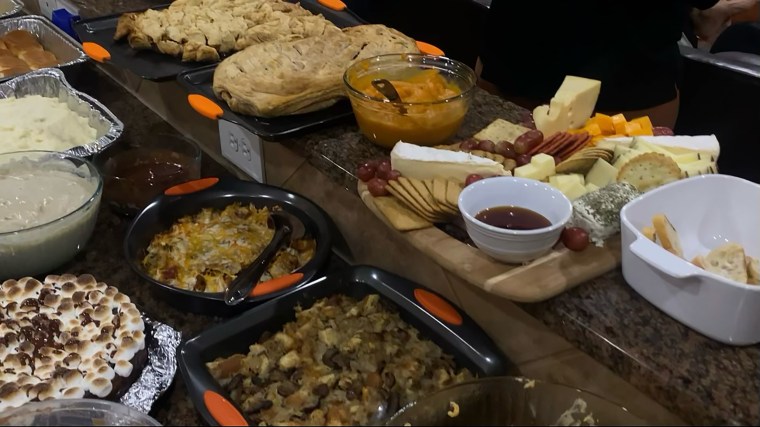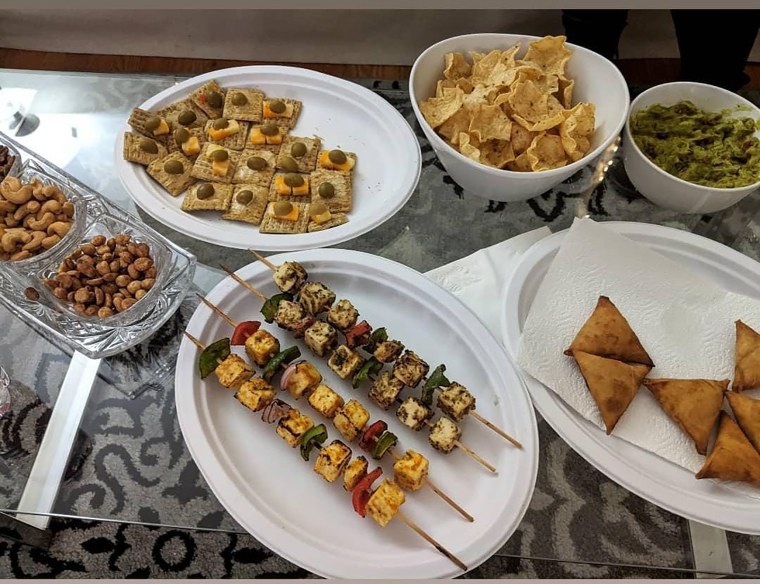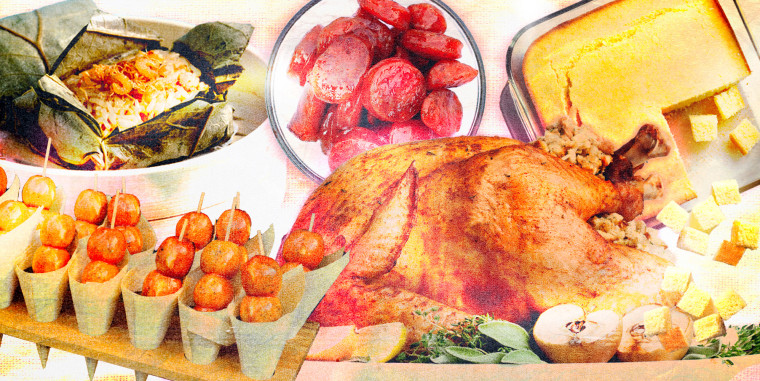As families across the U.S. prepare their turkeys and stuffing for Thanksgiving, Asian Americans are putting a unique spin on and finding their own meaning in the holiday, and it sometimes means busting out the hot pot, masalas and gochujang.
Many say they’re just building their own niche in a season they didn’t grow up celebrating, and others say their big communities have been carving out their own traditions for years now.
“For me and I think a lot of my friends who are in a similar kind of world, we have this nostalgia for American holidays when I didn’t grow up with them.”
— JET TILA, CHEF AND RESTAURATEUR
Erika Acosta, 20, and her Filipino American family celebrate Thanksgiving less traditionally. She said the annual holiday is always an excuse for her father to cook up a Brazilian steak or to indulge in Filipino noodle dishes, such as pancit canton and pancit palabok.
“We think turkey is too dry,” Acosta laughed, when asked why her family does not eat traditional Thanksgiving foods. “In the Philippines, we never really loved having turkey or any of the side dishes.”
Sweet potato mochi balls and miso green beans help some connect to holiday
Frankie Gaw, a Taiwanese American food content creator, said he jumped at the opportunity to reinvent Thanksgiving staples this year, drawing from his culture. His menu will feature sweet potato mochi balls drizzled with gochujang butter sauce. And instead of a green bean casserole, he’ll be serving green beans flash fried Din Tai Fung-style in a creamy miso mushroom sauce.
“I grew up loving green bean casserole as a kid even though I rarely eat it. It was this dish that I always saw from afar when my friends would talk about what they ate at Thanksgiving,” Gaw said in an email to NBC News. “I also wanted to honor the way my grandma cooks green beans, and I loved the idea of creating a green bean casserole dish without the casserole part since my grandma would have no idea what a casserole is.”
Thai and Chinese American celebrity chef and restaurateur Jet Tila — one of the minds behind Dragon Tiger Noodle Co. in Los Angeles and Pei Wei Asian Kitchen’s new menus — said his first-generation immigrant household hardly celebrated Thanksgiving.
“For me and I think a lot of my friends who are in a similar kind of world, we have this nostalgia for American holidays when I didn’t grow up with them,” Tila said.
This year, he unveiled an Asian American spin on a classic Southern Thanksgiving side dish with his Chinese sausage and chestnut rice dressing recipe. “I wanted to create dishes that were familiar to any of my Asian roots but were also familiar to ‘American traditional Thanksgiving,’” Tila said.
A Thai-Italian Diwalisgiving makes guests feel represented
Nimarta Narang’s first Thanksgiving dinner was in a college dining hall. Having grown up in Thailand, she wasn’t initially in love with the dorm versions of turkey, cranberry and pumpkin pie. But as an international student on a mostly empty campus, she was grateful to have it.
Now 28 with an Italian American partner, Narang’s most recent Thanksgiving involved a few more spices. She hosted a combined Friendsgiving and Diwali party in November, bringing all her friends together over some masala chicken parm.
“We feel more seen, we feel more represented ... and we feel more comfortable to share our different cultural practices without being shunned or made fun of."
— Nimarta Narang
“Masala pasta is a thing I grew up eating at home in Thailand,” she said. “His parents make really delicious chicken parmesan, and it’s something that he grew up eating.”
Together they crafted their fusion entree, and for dessert, their friend brought a South Asian-inspired tres leches cake, infused with cardamom, rose and saffron. She reflected on how Thanksgiving’s meaning is changing in this generation for young people of color specifically.
“We feel more seen, we feel more represented,” she said. “And we feel more comfortable to share our different cultural practices without being shunned or made fun of. Our holiday being combined together in the way that we want to experience, it shows a level of agency that people now have.”
Texas fusion and Sikh prayers bring families across continents together
Upneet Kaur, 21, has Thanksgiving celebrations packed with between 40 and 60 people. In a suburb of Houston, the family’s menu combines Sikh tradition, Texan fusion and classic American Thanksgiving food.
With much of her family being vegetarian, she said her Thanksgiving spread is, “largely based on the things that we can’t have.”

Nonvegetarian sides get reimagined with tofu or impossible meat, she said, with some staples such as mashed potatoes and mac and cheese being yearly staples on the table. Without Turkey as the centerpiece, Kaur’s family opts for something they’re all more accustomed to in the South.
“In terms of the main dish, it often just ends up being tacos,” she said. “It’s the food that a lot of people in my family are familiar with outside of Punjabi food. Since here in Texas, it’s largely available.”
“I wanted to create dishes that were familiar to any of my Asian roots but were also familiar to ‘American traditional Thanksgiving.’”
— jet tila
A small portion of daal and roti is also available for the picky eaters in the family who need their daily staple.
Her great-uncle leads the family in ardas, a Sikh prayer, every year to express gratitude at everyone being together. The family, once fragmented across continents, now grows in Houston every year, she said.
“I think the twist on dishes allows for everyone to come together,” she said.
Tandoori chicken for those solo on Thanksgiving
Ever since he arrived in the U.S., Sahej Preet Singh’s Thanksgivings have been a place for those with nowhere else to go. Those who can’t go to see their parents or parents missing their children are welcomed to his traditional Punjabi feast, with fresh vegetables picked from his farm in Monroe, New York.
Unimpressed with turkey meat, Singh, 36, decided tandoori chicken was an apt alternative during his first Thanksgiving as a host. Indian-style spicy mashed potatoes, or pav bhaji, is also a staple on his menu as a nod to the American mainstay.

“It’s not just that we don’t like the traditional food here, but it’s also because people are already used to having all of that,” he said. “We wanted to give them another perspective. We wanted to give them a taste of real, authentic Indian food.”
He rounds out the menu with butter chicken, paneer tikka and chickpea salad, with a dessert spread consisting of pie and brownies.
Having grown up in Punjab, Singh says he’s brought the community-oriented ideals of his upbringing to his new home here, including an open door policy. Thanksgiving is a time when that is exemplified the most.
“In India, we never used to lock our doors; my friends used to walk in and out all day long,” he said. “We brought those values here with us when we moved here. We want to be able to, not only help people get away from their loneliness, but spend time having a really nice meal, as well.”
